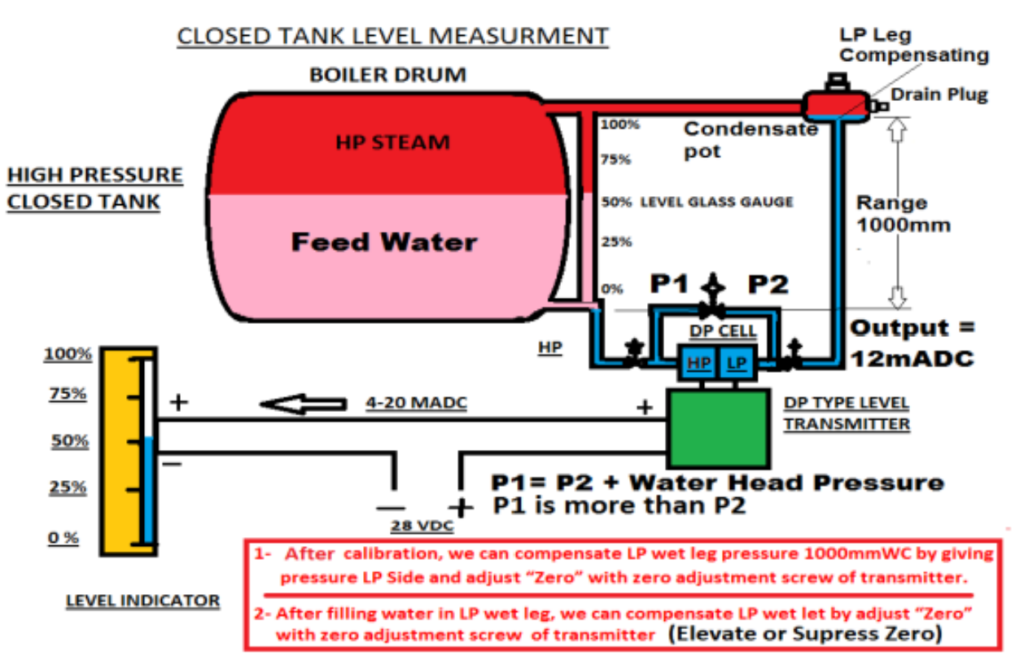A DP (Differential Pressure) Cell is an essential instrument used in various industries for measuring liquid level in closed tanks. This article delves into the working principles, applications, and advantages of using a DP Cell for closed tank level measurement.

Introduction
DP Cell, or Differential Pressure Cell, is a type of pressure sensor that measures the level of a liquid in a closed tank based on the principle of differential pressure. It is a widely used technique in industries such as chemical, petroleum, water treatment, and food processing.
Working Principle
The DP Cell operates by measuring the pressure difference between the bottom and the top of the liquid in the tank. This pressure difference is directly proportional to the liquid level. The cell comprises two pressure ports – the high-pressure side is connected to the bottom of the tank, and the low-pressure side is vented to the atmosphere or connected to the top of the liquid.
Drum Level in Boiler
When discussing drum level in a boiler, it’s essential to understand the concept of differential pressure and how it’s used to measure the water level within the boiler drum. This process is crucial for the efficient and safe operation of boilers. Let’s break down the key components of your statement to clarify how this measurement works:

Differential Pressure (DP) Measurement
- Differential Pressure (DP): In the context of a boiler drum, DP is used to determine the water level inside the drum. The DP is the difference in pressure between two points, commonly referred to as High Pressure (HP) and Low Pressure (LP).
- HP and LP Pressure Points: For measuring drum level:
- HP (High Pressure) point is typically connected to the bottom of the boiler drum.
- LP (Low Pressure) point is often connected at the top of the water level or at a point representing the minimum water level in the boiler drum.
- Calculating Differential Pressure: The formula used is: Differential Pressure=P1−P2 Where P1 is the pressure at the HP point, and P2 is the pressure at the LP point.
Application in Boiler Drum Level Measurement
- Understanding P1 and P2:
- P1 (HP Pressure): This is the pressure due to the head of water in the boiler drum above the HP tapping point.
- P2 (LP Pressure): This represents the pressure at the LP tapping point, which could be atmospheric pressure or a reference pressure point depending on the boiler design.
- Determining Water Level:
- The level of water in the boiler drum impacts the pressure at the HP tapping point. As the water level rises, the pressure at the HP tapping point (P1) increases due to the increased head of water.
- The differential pressure (P1 – P2) thus correlates with the water level in the drum. A higher differential pressure indicates a higher water level, while a lower differential pressure indicates a lower water level.
- Equation for Water Level:
- Using your formula, we can express it as: P1=P2+Water Level Head Pressure
- This equation indicates that the pressure at the HP point (P1) is equal to the LP pressure (P2) plus the pressure exerted by the water column (head pressure) in the tank.
Importance in Boiler Operations
- Safety and Efficiency: Accurate measurement of drum level is critical for the safety and efficient operation of the boiler. Incorrect water levels can lead to damage, inefficiency, and safety hazards.
- Automated Control Systems: Modern boilers use advanced control systems that continuously monitor and adjust the water level, based on the differential pressure measurements, to maintain optimal operation.
Types of DP Cells
- Traditional DP Cells: These are the basic models that measure differential pressure and require manual calculations to determine liquid level.
- Smart DP Cells: Equipped with microprocessors, these models automatically convert differential pressure readings into level measurements and can be integrated into digital control systems.
Installation and Calibration
Proper installation and calibration are crucial for accurate measurements. The DP Cell should be mounted at a specific height, and factors like the density of the liquid and tank geometry must be considered during calibration.
Applications
DP Cells are used in various applications, including:
- Monitoring water levels in reservoirs and treatment plants.
- Measuring the level of corrosive or high-temperature liquids in chemical processing.
- Controlling levels in food and beverage production tanks.
- Managing fuel levels in storage tanks in the petroleum industry.
Advantages
- Versatility: Suitable for a wide range of liquids, including corrosive and high-temperature fluids.
- Accuracy: Provides reliable and precise level measurements.
- Safety: Ideal for closed systems where direct contact with the liquid is not desirable.
- Integration: Easily integrates with modern digital control systems.
Challenges and Considerations
While DP Cells are highly effective, they do have some limitations:
- Sensitivity to changes in liquid density and temperature.
- Requires careful installation and calibration.
- Potential for drift over time, necessitating periodic recalibration.
Conclusion
DP Cells for closed tank level measurement offer a reliable and versatile solution for many industrial applications. Their ability to accurately measure liquid levels in a wide range of conditions makes them an invaluable tool in process control and monitoring. However, proper installation, calibration, and maintenance are essential to ensure their effectiveness and accuracy.
This technology continues to evolve with advancements in electronics and material sciences, promising even greater efficiency and adaptability in the future.
Read Full Course on Instrumentation and Control Engineering.